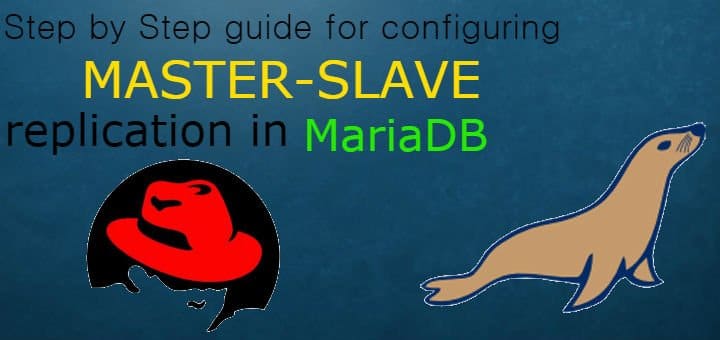In our earlier tutorials,we have already learned to install & configure MariaDB & also learned some basic administration commands for managing MariaDB. We are now going to learn to setup a MASTER SLAVE replication for MariaDB server.
Replication is used to create multiple copies of our database & these copies then can either be used as another database to run our queries on, queries that might otherwise affect performance of master server like running some heavy analytics queries or we can just use them for data redundancy purposes or for both. We can automate the whole process i.e. data replication occurs automatically from master to slave. Backups are be done without affecting the write operations of the master
So we will now setup our master-slave replication, for this we need two machines with Mariadb installed. IP addresses for the both the machines are mentioned below,
Master – 192.168.1.120 Hostname- master.ltechlab.com
Slave – 192.168.1.130 Hostname – slave.ltechlab.com
Once MariaDB has been installed in those machines, we will move on with the tutorial. If you need help installing and configuring maridb, have a look at our tutorial HERE.
Step 1- Master Server Configuration
We are going to take a database named ‘important’ in MariaDB, that will be replicated to our slave server. To start the process, we will edit the files ‘/etc/my.cnf’ , it’s the configuration file for mariadb,
$ vi /etc/my.cnf
& look for section with [mysqld] & then enter the following details,
[mysqld]
log-bin
server_id=1
replicate-do-db=important
bind-address=192.168.1.120
Save & exit the file. Once done, restart the mariadb services,
$ systemctl restart mariadb
Next, we will login to our mariadb instance on master server,
$ mysql –u root –p
& then will create a new user for slave named 'slaveuser' & assign it necessary privileges by running the following command
STOP SLAVE;
GRANT REPLICATION SLAVE ON *.* TO 'slaveuser'@'%' IDENTIFIED BY 'iamslave';
FLUSH PRIVILEGES;
FLUSH TABLES WITH READ LOCK;
SHOW MASTER STATUS;
Note:- We need values from MASTER_LOG_FILE and MASTER_LOG_POS from out of 'show master status' for configuring replication, so make sure that you have those.
Once these commands run successfully, exit from the session by typing ‘exit’.
Step2 – Create a backup of the database & move it slave
Now we need to create backup of our database ‘important’ , which can be done using ‘mysqldump’ command,
$ mysqldump –u root –p important > important_backup.sql
Once the backup is complete, we need to log back into the mariadb & unlock our tables,
$ mysql –u root –p
$ UNLOCK TABLES;
& exit the session. Now we will move the database backup to our slave server which has a IPaddress of 192.168.1.130,
$ scp important_backup.sql root@192.168.1.130:/data
This completes our configuration on Master server, we will now move onto configuring our slave server.
Step 3 Configuring Slave server
We will again start with editing ‘/etc/my.cnf’ file & look for section [mysqld] & enter the following details,
[mysqld]
server-id = 2
replicate-do-db=important
[...]
We will now restore our database to mariadb, by running
$ mysql -u root -p < /data/ important_backup.sql
When the process completes, we will provide the privileges to ‘slaveuser’ on db ‘important’ by logging into mariadb on slave server,
$ mysql –u root –p
GRANT ALL PRIVILEGES ON important.* TO 'slaveuser'@'localhost' WITH GRANT OPTION;
FLUSH PRIVILEGES;
Next restart mariadb for implementing the changes.
$ systemctl restart mariadb
Step 4 Start the replication
Remember, we need MASTER_LOG_FILE and MASTER_LOG_POS variables which we got from running ‘SHOW MASTER STATUS’ on mariadb on master server. Now login to mariadb on slave server & we will tell our slave server where to look for the master by running the following commands,
STOP SLAVE;
CHANGE MASTER TO MASTER_HOST='192.168.1.110', MASTER_USER='slaveuser', MASTER_PASSWORD='iamslave', MASTER_LOG_FILE='mariadb-bin.000001', MASTER_LOG_POS=460;
START SLAVE;
SHOW SLAVE STATUS\G;
Note:- Change details of your master as necessary.
Step 5 Testing the replication
We will now create a new tables in our database on master to make sure if the replication is working or not. So, login to mariadb on master server,
$ mysql –u root –p
select the database 'important',
use important;
and create a table named test in the db,
create table test (c int);
then insert some value into it,
insert into test (c) value (1);
To check the added value,
select * from test;
& you will find that your db has a table has the value you inserted.
Now let’s login to our slave database to make sure if our data replication is working,
$ mysql –u root –p
$ use important;
$ select * from test;
You will see that the output shows the same value that we inserted on the master server, hence our replication is working fine without any issues.
This concludes our tutorial, please send your queries/questions through the comment box below.
If you think we have helped you or just want to support us, please consider these :-
Connect to us: Facebook | Twitter | Google Plus
Become a Supporter - Make a contribution via PayPal
[paypal_donation_button align="left" border="1"]
Linux TechLab is thankful for your continued support.

step4 SLAVE START shoule be “START SLAVE”
Thanks, updated it !!!
Hello admin, i’ve been reading your posts for some time
and I really like coming back here. I can see that you probably
don’t make money on your site. I know one awesome method of earning money, I think you will like it.
Search google for: dracko’s tricks
Step 1 – under [mysqld] block, server_id should be server-id.
I like it
I like it